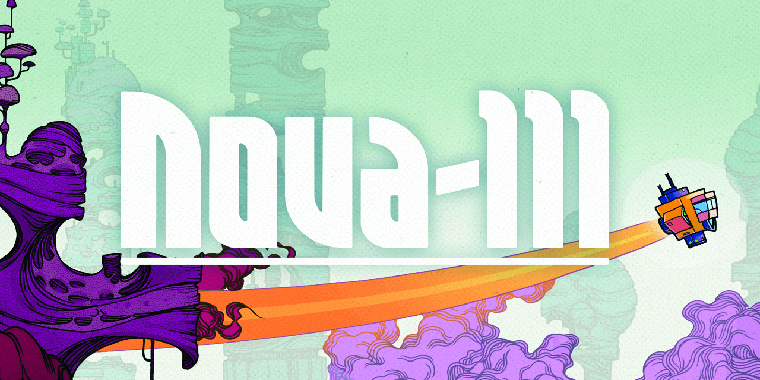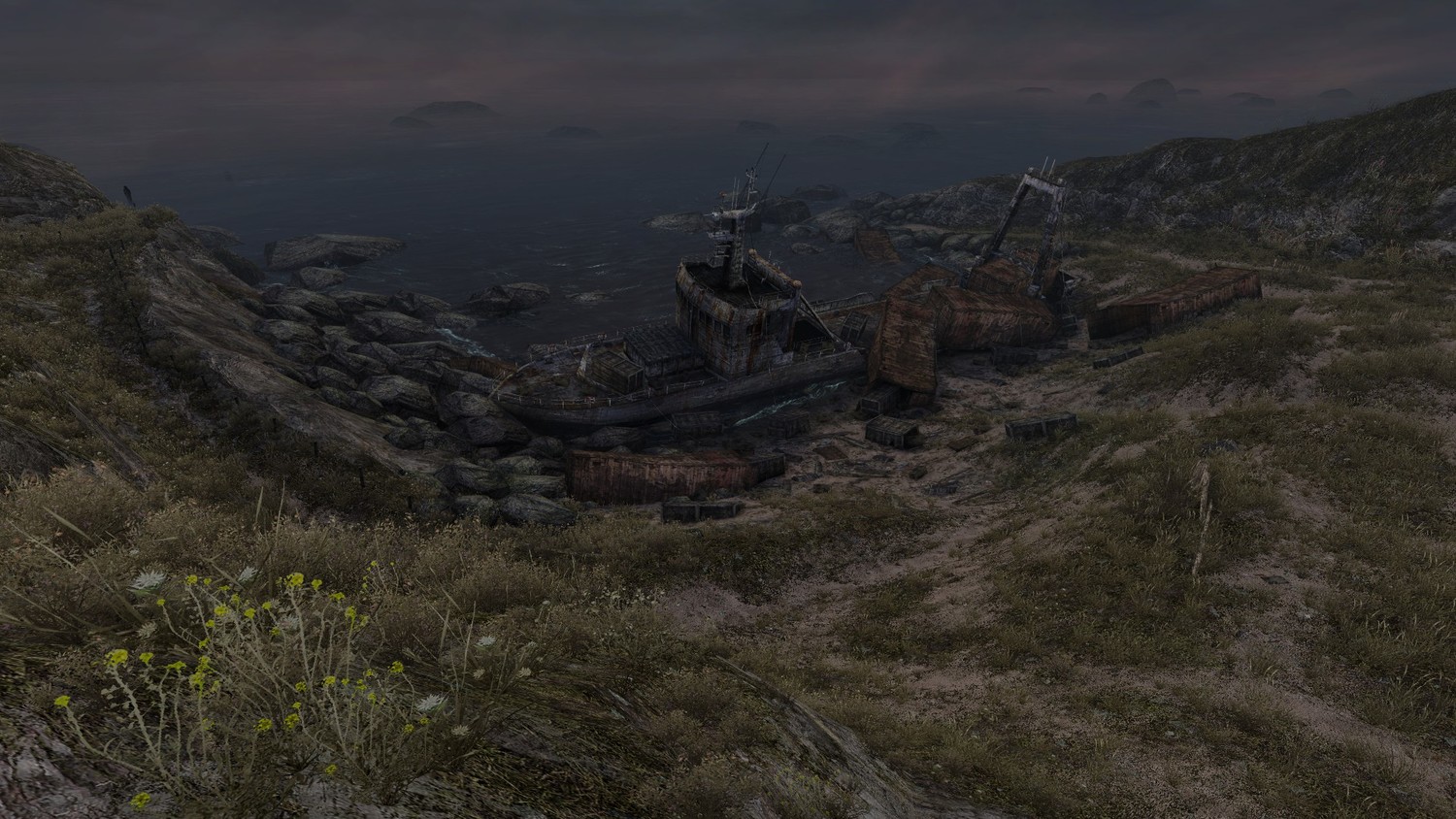
Review: Nova-111
Posted by Eric G on September 2nd, 2015 | 0 Comments | Tags: Funktronic Labs , Nova-111
The most difficult thing about Nova-111, I’ve found, is figuring out how to explain it to someone who isn’t a games aficionado. Funktronic Labs have made something special, and I want so very badly to share it with friends/family, but I get jammed up every time I start to explain it. Let me try in writing, as I’m a bit better at that.
Nova-111 is a paradoxical game in that it runs at real-time while also being turn-based. In booting up the game, you’ll note (consciously or not) that your ship exists on a grid. It happens to take up most of the space in that grid, as a matter of fact. Pressing a directional button moves you one space in that direction. A turn counter in the bottom right-hand corner increases by one. One turn has gone by. Still with me? Good. It won’t be long before you run into an enemy who won’t do anything until you do. The first few enemies move and attack according to turns. If you move, the enemy will probably move. If you skip a turn by pressing X (a sometimes tactical maneuver), that still counts as a turn and the enemy may act if within range. Most combat is handled using the ship’s all-purpose body-check – running directly into an adjacent enemy. The first few enemies also attack based on turns. Once in range, the enemy will show a visual cue that means it’s going to attack next turn. At that point, you can dodge the attack by moving to an out-of-range tile, if that’s your best option. The ‘A-ha! That’s genius!’ bulb gets brighter once the second enemy, The Blinker, is introduced.
Blinkers move in turn, but when they move, they leave behind a bomb that explodes in real-time. No matter what actions you take (or don’t), the bomb will explode in about two seconds. It’s such an elegant, logical blending of mechanics that I couldn’t help but grin widely when it clicked. Each planet contains a few zones, which in turn contain a few sectors. The game introduces new abilities, enemy types, and environmental obstacles in a digestible manner; you won’t feel confused or overwhelmed as you make your way through the game. The abilities (called modules) are typically introduced to overcome environmental obstacles or deal with new enemy types, so there’s a woven synergy to all of the additional layers. The Beam module, for example, will shoot up to two tiles. It’s necessary for breaking through heavy rocks and useful for dealing with spiky-armored enemies. Your area-of-effect bomb is filled up and stored by collecting polygel, small yellow spheres. Science abilities regenerate in a number of turns. (Pro-tip: Science regenerates faster if you skip a turn by pressing X.)
The objective on each sector is to find the exit warp. Like PixelJunk Shooter, though, there are scientists and secret areas hidden in each sector. At the end of each zone, you’re shown statistics on how long it took you to complete the zone, the number of turns taken, the number of scientists found/total number of scientists, and the number of secret areas found/total number of secrets. Each zone has two separate leaderboards – one for time taken; one for turns taken. There are 111 scientists marooned across all planets, hence the title of the game. The plot is decent, something about an explosion that fused real-time and turn-time, scattering scientists after a massive explosion. What’s best about the story is the writing. For just about the entire game, you’ll have Dr. Science piping up here and there, giving you hints on how to play or furthering the story. He’s genuinely charismatic, an alienated geologist who’s trying to make sense of the aftermath along with you. I enjoyed most of his quips and was only a bit put off by how quickly he offers a tip to the solution of a puzzle.

I love the art style of the entire game. The environments are varied, the 3d-ish nature of the ship is thematically fitting, and the character portraits are well-drawn. Early on, I had a bit of difficulty discerning some of the art as being background or foreground. It led to getting cornered by enemies once or twice, but I didn’t notice it as being a problem later on. The map is serviceable; minimalistic in its design but getting the point across that traverseable terrain is white, blockades are pink, and collectibles are red. It’s nice that you can move with the map up, but I wish you could zoom in as it’s a bit small for my eyes. The music is fitting, your typical spacely soundtrack – moody, with bleeps and bloops that make melodies here and there. I had read that the music changes according to your playstyle but didn’t notice it while playing. I’ll have to go back and check for that.
Nova-111 is excellent. There’s enough content that’s introduced with comfortable pacing to keep the player engaged through completion. New science modules, enemy types, environmental hazards, etc. make the player feel like s/he’s ever-learning and ever-mastering. I don’t want to spoil any of the late-game content, but some of the enemy types and puzzle designs floored me. Also, I’m a pretty sleuthy gamer and was surprised by how many secrets and scientists I left undiscovered in some of the zones. I unlocked New Game+ and played a few worlds. There are some neat little modifiers, but I feel like, given the new character you play as, something more could have been done to make it more enthralling a second go-around. Also, I dream of what this game could do with two players, either cooperatively or competitively. As is, it’s still a fantastic action/puzzle/strategy/adventure game, and one of the best overall games I’ve played all year.
Note: The game runs fine on Vita, but there’s no cross-save option at the moment. I couldn’t even upload to PS+ from PS4 then download to Vita. I guess I’ll have to play through it again on the go! It’s triple cross-buy, so this misstep is forgivable.
A copy of this game was provided by the publisher for review purposes. For more info on our review policy click here.
General Info
- Developer: Funktronic Labs
- Publisher: Curve Studios
- Platforms: PS Vita, PS3, PS4
- Release Date: August 2015, September 2015
- Price: $14.99, £11.99/€14.99/AU$22.95
- Genre: Exploration, Real-Time-Strategy, Turn-Based Strategy
Score:
What I Like:
- Logical, elegant combination of real-time and turn-time.
- Art style of entire game is colorful, great.
- Funny writing.
- Secrets are fun.
What I Dislike:
- New Game+ could be a little bit more.












































